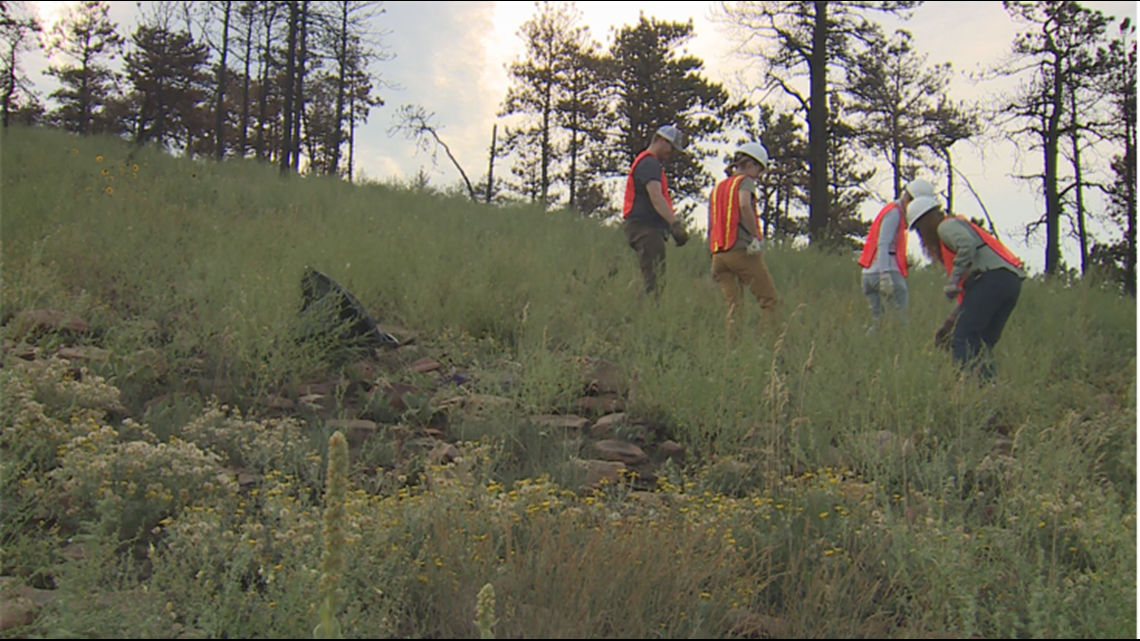BOULDER, Colo. — The Calwood Fire, like other wildfires in Colorado, left behind devastation in Boulder County.
But it also allowed for the growth of a weed that Boulder County is trying to get rid of Rush Skeletonweed.
"It displaces a lot of our native vegetation on the hillsides, reducing habitat, our wildlife habitat, pollinator species and just generally being a pain," said Boulder County Weed Specialist Joe Swanson.
He said that every Monday, he and his team have been working on cutting the invasive weed before its population blooms even more in the Heil Valley Ranch area at the Calwood Fire burn scar.
"...we're probably up over 20 thousand plants that we've pulled or clipped up here on the hillside," Swanson said.
But a nonprofit out of Longmont is also stepping in to help.


What is Rush Skeletonweed?
The Colorado Department of Agriculture lists Rush Skeletonweed as a "List A" Noxious Weed Species.
That means it's designated for eradication.
First discovered in Boulder County in around 2011 or 2012, Swanson said that the Calwood Fire last year allowed the weed to bloom more.
One impact the weed has is on the native plants trying to grow back.
"...fire tends to open up the landscape and reduce the competition for our invasive plants, which tend to have a much greater ability to expand quicker on sites with less resources than what our native plants usually have," he said. "...So they can fill the site and start occupying the site and using all of the nutrients that are in the ground, the water resources prior to the native vegetation coming up and being able to to compete with them. So then it's a struggle for our native plants to come back."
That could also lead to a displacement in wildlife, among other things.
"It displaces a lot of our native vegetation on the hillsides, reducing habitat, our wildlife habitat, pollinator species and just generally being a pain," he said.
Swanson adds that the area it's appeared in is the only place in the state where it can be found.
"And this is a native of Europe and Asia and Northern Africa. They think it arrived in the US back in about 1938. They said it could been here even as early as 1900, but it was first found in Washington state in1938 and then in California in about 1965," he said.
To get rid of them initially, he said it's important to try and control the flowers on the weed from propagating.
"...But we have learned that by pulling it, this plant does propagate through the roots, through little roots and shoots off of those roots. And by pulling it, we aggravate it. It actually sends a signal to release more of these dottore plants off of the roots," he said. "So studies have shown you're better off to clip it until you can actually treat it with a herbicide. So if we clip it off, you'd get fewer of those dottore plants coming off of the roots."
It's a good thing they're continuing to remove the weed because Swanson said that the long-term impact wouldn't be good.
"The long term impact, is we would probably have a complete hillside and probably throughout the rest of the county, displacing wildlife habitat tremendously, just displacing our native vegetation," he said.
But luckily, they, along with other volunteers, are working hard to get rid of the weed.


Volunteers step in
Thursday was the second time volunteers who signed up through the Longmont-based nonprofit Can'd Aid were out in the burn scar area helping out Boulder County.
The Program Coordinator Abbi Arneson said they capped both projects at 30 people because of the number of parking spaces, but they reached their max capacity both times.
“This entire part of Heil Valley Ranch is very well used, well loved and it’s accessible in Boulder County," she said. "And it was really devastating when the Calwood fire came through….”
Overall, she said the fact that registration hit its max said a lot about the community.
“So it really shows a lot that this many people are willing to come out and spend a couple hours pulling weeds," she said.
Swanson with Boulder County also said he is grateful for the help.
"I can't thank them enough for coming out to help us track these down and and get them under control," said Swanson.
He hopes that someday they can get more volunteers out there on potentially a monthly basis.
SUGGESTED VIDEOS: Wildfires in Colorado

